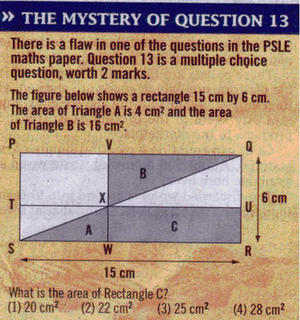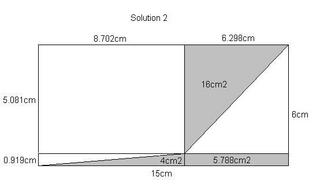2 Marks' Worth
 After all the brouhaha over a PSLE Math question, MOE finally admitted that the question was flawed. But wait a minute... Is it really wrong?
After all the brouhaha over a PSLE Math question, MOE finally admitted that the question was flawed. But wait a minute... Is it really wrong?Actually the problem itself looks perfectly legitimate to me (provided the papers didn't missed out any other information). This is because, like what some who wrote in said, you can't assume that the diagonal SXQ is a straight line. If you've taken an exam like the GRE, you'll know never to make such an assumption. But of course, we can't expect Primary 6 students to know that.
You can redraw the figure in different scales to get very different perceptions, as long as the dimensions given are consistent. So the whole figure, unlike what the papers said, is not mathematically impossible.
Anyway, I tried working out the solution. Yes, I can be quite boliao at times, haha, but how can I resist such a controversial question? And I haven't done math for a long time! I obtained two solutions via working out 4 simultaneous equations. The problem is my answers don't match any of the multiple-choice options.
Take a look. Looking at my pictures, you definitely won't think the long diagonal is a straight line!

 Let me know if I got anything wrong. If it's ok, then it's two marks for me too! :D
Let me know if I got anything wrong. If it's ok, then it's two marks for me too! :D
3 Comments:
Huh! My answers are serious.. why u find them funny??
Whatever, ha! :)
On hindsight, and strictly speaking, my solutions made some assumptions too. Anyone can guess?
wat r the assumptions u made????
Ok, dun shoot me for this..
I made an assumption i said i shdn't make, ie i assumed tat TXU and VXW are straight lines. The qn said tat PQRS and XWRU are rects, but it doesn't say anything abt TX and VX being horizontal and vertical respectively.
i know, i'm being ridiculous! Cos if they aren't then it's not solveable. Or at least i can't!
Post a Comment
<< Home